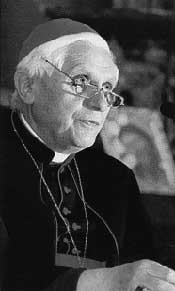On
February 2, Bishop Fellay gave a press conference in Rome with
about 45 journalists present. At a time when rumours of secret
negotiations between the SSPX and the Vatican, what they got
was not what they expected. Instead of the expected announcement
of a deal, Bishop Fellay released a letter to Cardinals and
a long study on ecumenism entitled “From Ecumenism to Silent
Apostasy – 25 Years of Pontificate”. You can obtain this
study by writing to me or by going to our web site www.sspx.ca.
The term
“silent apostasy” is one used by Pope John Paul II to describe
the state of Catholicism in Europe and the world today. This
study clearly demonstrates that one of the main reason for this
silent apostasy is ecumenism as practiced today by the Vatican,
from the Pope on down. Bishop Fellay shows clearly and simply
by quoting Pope John Paul II that ecumenism emanates from the
conciliar “magna carta” Lumen Gentium and is the main
object of his pontificate. Vatican II and John Paul II are therefore
responsible for this silent apostasy. I’ll try to summarize
the whole thing. If this doesn’t make sense it is a good sign.
It’s not supposed to make sense. It is logical but nonsensical.
It’s not Catholic.
Cardinal
Walter Kasper, in a recent conference, ‘A Vision of Christian
Unity for the Next Generation’, admits that there is a
pre-Vatican II and a post-Vatican II ecumenism. The pre-Vatican
II ecumenism consisted in the conversion, the return of those
who had left the one true Church. The post-Vatican II ecumenism
is very different. It consists in “the common path”, “reconciled
diversity”, as a means of arriving at some kind of unity
with other “Churches”. So there is no idea of return,
of coming back.
If in the
past, the Church worked for the conversion of non-Catholics
it was for heir salvation. Now there is no need to work for
the salvation of souls anymore. Why? Because for the Pope, everyone
is saved because “Jesus Christ ‘has united himself in a
certain way to all men’ (Gaudium et Spes nº 22), even if
these men are not aware of it.” (JP II 22/12/86) So being
freed from the need to help all men attain their salvation,
the Church can now devote Herself to promoting the lost unity
of mankind!
This entirely
new non-Catholic concept of ecumenism comes from a new idea
found in the document of Vatican II Lumen Gentium (# 7&8),
which speaks separately of the “Church body of Christ” and the
visibility of the Catholic Church as if they are two different
realities. The Pope, following Vatican II, makes a distinction
between the “Church of Christ” which is a divine reality
and the different Churches which spring from human divisions.
For Vatican II and John Paul II, the Church of Christ is a larger
reality than the visible Catholic Church. It includes all the
baptized, considered disciples of Christ, despite all the divisions.
This Church of Christ is an interior reality. This explains
the affirmation found in Lumen Gentium that the Church of Christ
subsists in the Catholic Church. For them the Catholic Church
is not the Church of Christ, contrary to what Pius XII and all
Popes expressly taught, but it is part of the Church of Christ,
which includes all “Christian” churches. This is why the Orthodox
churches are seen as “sister churches”, and all religions are
instruments which the Holy Ghost makes use of in bringing men
to God. This is why there is no more need for non-Catholics
to convert because as, John Paul II often says following Lumen
Gentium, the baptized regardless of which church he belongs
to, remains united to Christ and incorporated to Him (LG #15).
The conclusion is that if the order of unity “is one that
goes back to creation and redemption and is in some way ‘divine’
then all the differences even religious are man made.” (JP
II 22/12/86)
From this
it follows that for John Paul II, “The ultimate goal of
the ecumenical movement is to re-establish full visible unity
among all the baptized” (JP II Ut Unum Sint #77) and therefore,
it is necessary to tear down all the man made barriers to visible
unity. Here you have the reasons for the papal apologies of
the year 2000 and all other concessions made to non-Catholic
religions.
How Will This Visible Unity Be Realized?
Through
the traditional visible signs of unity: the Profession
of Faith, the Sacraments and the Hierarchy.
But remember, it is not a matter of returning to the one true
Fold but of finding some common ground around which we can all
be united. This is what explains the demolition of our Church
in the name of ecumenism.
Profession
of Faith
 |
|
Cardinal
Ratzinger |
|
When it
comes to the Faith, John Paul II considers that often “intolerant
polemics and controversies have made incompatible assertions
out of what was really the result of two different ways of looking
at the same reality. Nowadays we need to find the formula which,
by capturing the reality in its entirety, will enable us to
move beyond partial readings and eliminate false interpretations.”
(JP II Ut Unum Sint #38) This will be done by
historical relativism to make the dogmatic formula depend on
the time they were drawn up. Different times need different
formulas; it is as simple as that. This is exactly what Cardinal
Ratzinger told Archbishop Lefebvre. When asked if the Syllabus
of errors of Pius IX was still true today he replied: The Syllabus
was for the 19th century, it doesn’t apply anymore
today. Then there is no definite truth anymore.
All the
quarrels on the faith were in a large measure a misunderstanding
of terminology and there were faults on both sides. So the Faith
is thrown out the large open window of Vatican II in the name
of ecumenism; to witness the Common Christological declaration
between the Catholic and Assyrian Churches of 1994 and the Joint
Declaration on Justification between the Lutheran Federation
and the Catholic Church of 1999.
The Sacraments
Remember
that according to Father Bugnini, in the new Mass “the Church
has been guided […] by the desire to do everything
to help our separated brethren on the way to union, taking away
the stones that could be even the shadow of a risk of stumbling
block or displeasure.” This of course was done by taking
away what was expressly and properly Catholic from the new Mass.
The entire liturgical reform was made with the same desire in
mind.
But it
goes even farther. The Catholic liturgy having been sufficiently
watered down to be acceptable to non-Catholics, it remained
to accept the liturgies of the separated brethren. In a document
expressly approved by John Paul II, Cardinal Ratzinger has declared
valid the anaphora “Addaï and Mari”, of the Assyrian
Church which broke away after the 3rd Council of
Ephesus (381), a “Mass” in which the words of consecration
are not said (no form). This represents the end of the theology
of the sacraments since matter and form are no longer deemed
necessary. What then is the problem with the Last Supper of
the Protestants?
But the
main obstacle to unity remains the hierarchy and especially
the primacy of the Roman Pontiff. But have no fear it has all
been taken care of.
The
Hierarchy
But first
there is the necessity of recognizing the orders of all the
different churches. So they must remove the obstacle of the
invalidity of Anglican orders decreed by Leo XIII, in order
that the Archlayman of Canterbury can bless the cardinals with
the Pope. To legitimatize the Orthodox, they must redefine the
meaning of apostolic succession, which is no longer understood
“in the sense of an historical chain of laying on of hands
running back through the centuries to one of the apostles”
since “this would be a very mechanical and individualistic
vision…” (Cardinal Kasper)
But the main stumbling block remains the Pope, the Primacy of
the Roman Pontiff. Again Pope John Paul II has taken the lead:
in No. 95 of his encyclical "Ut Unum Sint,"
he proposed to pastors and theologians that they “find a
way of exercising the primacy which, while in no way renouncing
what is essential to its mission, is nonetheless open to a new
situation.” And voilà; “in the future the Petrine
ministry has to be exercised in line with the changing needs
of the Church… Because “in our globalized world situation
the biblical testimonies on Peter and the Petrine tradition
of Rome are read with new eyes because in this new context the
question of a ministry of universal unity, a common reference
point and a common voice of the universal church, becomes urgent.”
(Cardinal Kasper) This is the end of the papacy in the
name of ecumenism. And we are the ones who are against the Pope!
Unbelievable!
I wish I were making this up. But these are quotes from John
Paul II and his right hand man in the field of ecumenism Cardinal
Walter Kasper, President of the Pontifical Council for Promoting
Christian Unity.
Dear faithful
Lent has started. With St Paul “we do exhort you, that you
receive not the grace of God in vain. Behold now is the acceptable
time; behold now is the day of salvation.” Be generous!
There is much to expiate: our own sins but also the many public
scandals committed around us. As usual the monthly Mass for
all our friends and benefactors will be offered on the last
Sunday of the month. Be assured of our prayers.



